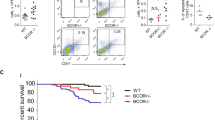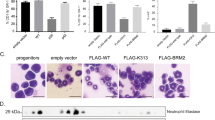Abstract
Acquired mutations in the hematopoietic transcription factor GATA binding protein-1 (GATA1) are found in megakaryoblasts from nearly all individuals with Down syndrome with transient myeloproliferative disorder (TMD, also called transient leukemia) and the related acute megakaryoblastic leukemia (DS-AMKL, also called DS-AML M7)1,2,3,4,5,6. These mutations lead to production of a variant GATA1 protein (GATA1s) that is truncated at its N terminus. To understand the biological properties of GATA1s and its relation to DS-AMKL and TMD, we used gene targeting to generate Gata1 alleles that express GATA1s in mice. We show that the dominant action of GATA1s leads to hyperproliferation of a unique, previously unrecognized yolk sac and fetal liver progenitor, which we propose accounts for the transient nature of TMD and the restriction of DS-AMKL to infants. Our observations raise the possibility that the target cells in other leukemias of infancy and early childhood are distinct from those in adult leukemias and underscore the interplay between specific oncoproteins and potential target cells.
This is a preview of subscription content, access via your institution
Access options
Subscribe to this journal
Receive 12 print issues and online access
$209.00 per year
only $17.42 per issue
Buy this article
- Purchase on Springer Link
- Instant access to full article PDF
Prices may be subject to local taxes which are calculated during checkout





Similar content being viewed by others
Accession codes
References
Wechsler, J. et al. Acquired mutations in GATA1 in the megakaryoblastic leukemia of Down syndrome. Nat. Genet. 32, 148–152 (2002).
Hitzler, J.K., Cheung, J., Li, Y., Scherer, S.W. & Zipursky, A. GATA1 mutations in transient leukemia and acute megakaryoblastic leukemia of Down syndrome. Blood 101, 4301–4304 (2003).
Rainis, L. et al. Mutations in exon 2 of GATA1 are early events in megakaryocytic malignancies associated with trisomy 21. Blood 102, 981–986 (2003).
Mundschau, G. et al. Mutagenesis of GATA1 is an initiating event in Down syndrome leukemogenesis. Blood 101, 4298–4300 (2003).
Xu, G. et al. Frequent mutations in the GATA-1 gene in the transient myeloproliferative disorder of Down's syndrome. Blood 102, 2960–2968 (2003).
Ahmed, M. et al. Natural history of GATA1 mutations in Down syndrome. Blood 103, 2480–2489 (2004).
Gurbuxani, S., Vyas, P. & Crispino, J.D. Recent insights into the mechanisms of myeloid leukemogenesis in Down syndrome. Blood 103, 399–406 (2004).
Blobel, G.A., Simon, M.C. & Orkin, S.H. Rescue of GATA-1-deficient embryonic stem cells by heterologous GATA-binding proteins. Mol. Cell. Biol. 15, 626–633 (1995).
Visvader, J.E., Crossley, M., Hill, J., Orkin, S.H. & Adams, J.M. The C-terminal zinc finger of GATA-1 or GATA-2 is sufficient to induce megakaryocytic differentiation of an early myeloid cell line. Mol. Cell. Biol. 15, 634–641 (1995).
Weiss, M.J., Yu, C. & Orkin, S.H. Erythroid-cell-specific properties of transcription factor GATA-1 revealed by phenotypic rescue of a gene-targeted cell line. Mol. Cell. Biol. 17, 1642–1651 (1997).
Shimizu, R., Takahashi, S., Ohneda, K., Engel, J.D. & Yamamoto, M. In vivo requirements for GATA-1 functional domains during primitive and definitive erythropoiesis. EMBO J. 20, 5250–5260 (2001).
Kuhn, R., Schwenk, F., Aguet, M. & Rajewsky, K. Inducible gene targeting in mice. Science 269, 1427–1429 (1995).
Shivdasani, R.A., Fujiwara, Y., McDevitt, M.A. & Orkin, S.H. A lineage-selective knockout establishes the critical role of transcription factor GATA-1 in megakaryocyte growth and platelet development. EMBO J. 16, 3965–3973 (1997).
Vyas, P., Ault, K., Jackson, C.W., Orkin, S.H. & Shivdasani, R.A. Consequences of GATA-1 deficiency in megakaryocytes and platelets. Blood 93, 2867–2875 (1999).
Rylski, M. et al. GATA-1-mediated proliferation arrest during erythroid maturation. Mol. Cell. Biol. 23, 5031–5042 (2003).
Welch, J.J. et al. Global regulation of erythroid gene expression by transcription factor GATA-1. Blood 104, 3136–3147 (2004).
Weiss, M.J., Keller, G. & Orkin, S.H. Novel insights into erythroid development revealed through in vitro differentiation of GATA-1 embryonic stem cells. Genes Dev. 8, 1184–1197 (1994).
Tsai, F.Y. et al. An early haematopoietic defect in mice lacking the transcription factor GATA-2. Nature 371, 221–226 (1994).
Scott, E.W., Simon, M.C., Anastasi, J. & Singh, H. Requirement of transcription factor PU.1 in the development of multiple hematopoietic lineages. Science 265, 1573–1577 (1994).
Georgopoulos, K. et al. The Ikaros gene is required for the development of all lymphoid lineages. Cell 79, 143–156 (1994).
Martin, D.I. & Orkin, S.H. Transcriptional activation and DNA binding by the erythroid factor GF-1/NF-E1/Eryf 1. Genes Dev. 4, 1886–1898 (1990).
Hitzler, J.K. & Zipursky, A. Origins of leukaemia in children with Down syndrome. Nat. Rev. Cancer 5, 11–20 (2005).
McDevitt, M.A., Fujiwara, Y., Shivdasani, R.A. & Orkin, S.H. An upstream, DNase I hypersensitive region of the hematopoietic-expressed transcription factor GATA-1 gene confers developmental specificity in transgenic mice. Proc. Natl. Acad. Sci. USA 94, 7976–7981 (1997).
Crispino, J.D., Lodish, M.B., MacKay, J.P. & Orkin, S.H. Use of altered specificity mutants to probe a specific protein-protein interaction in differentiation: the GATA-1:FOG complex. Mol. Cell 3, 219–228 (1999).
Crispino, J.D. GATA1 mutations in Down syndrome: implications for biology and diagnosis of children with transient myeloproliferative disorder and acute megakaryoblastic leukemia. Pediatr. Blood Cancer 44, 40–44 (2004).
Gagneten, S., Le, Y., Miller, J. & Sauer, B. Brief expression of a GFP cre fusion gene in embryonic stem cells allows rapid retrieval of site-specific genomic deletions. Nucleic Acids Res. 25, 3326–3331 (1997).
Keller, G., Kennedy, M., Papayannopoulou, T. & Wiles, M.V. Hematopoietic commitment during embryonic stem cell differentiation in culture. Mol. Cell. Biol. 13, 473–486 (1993).
Li, C. & Wong, W.H. Model-based analysis of oligonucleotide arrays: expression index computation and outlier detection. Proc. Natl. Acad. Sci. USA 98, 31–36 (2001).
Vyas, P., Norris, F.A., Joseph, R., Majerus, P.W. & Orkin, S.H. Inositol polyphosphate 4-phosphatase type I regulates cell growth downstream of transcription factor GATA-1. Proc. Natl. Acad. Sci. USA 97, 13696–13701 (2000).
Acknowledgements
We thank H. Hock, Y. Fujiwara and J.-P. Bourquin for suggestions and technical assistance; C. Browne and O. Ogai for technical assistance with ES cell targeting; A. Williams and N. Stokes for help with transgenic mice; M. Hamblen for general lab support; and R. Shivdasani and Z. Chen for discussion and help on megakaryocyte ex vivo culture. Z.L. is a Fellow of the Leukemia & Lymphoma Society. J.-H.K. is supported by the German National Academic Foundation and the AML-BFM Study Group. This work was supported by grants to S.H.O. from the US National Institutes of Health. S.H.O. is an Investigator of the Howard Hughes Medical Institute.
Author information
Authors and Affiliations
Corresponding author
Ethics declarations
Competing interests
The authors declare no competing financial interests.
Supplementary information
Supplementary Fig. 1
Targeting strategies. (PDF 48 kb)
Supplementary Fig. 2
GATA1e2fl conditional knockin. (PDF 168 kb)
Supplementary Fig. 3
AChE and antibody staining. (PDF 203 kb)
Supplementary Table 1
Summary of the microarray data. (PDF 164 kb)
Supplementary Table 2
Primer sequences. (PDF 20 kb)
Rights and permissions
About this article
Cite this article
Li, Z., Godinho, F., Klusmann, JH. et al. Developmental stage–selective effect of somatically mutated leukemogenic transcription factor GATA1. Nat Genet 37, 613–619 (2005). https://doi.org/10.1038/ng1566
Received:
Accepted:
Published:
Issue Date:
DOI: https://doi.org/10.1038/ng1566
This article is cited by
-
Inherent genome instability underlies trisomy 21-associated myeloid malignancies
Leukemia (2024)
-
A new genomic framework to categorize pediatric acute myeloid leukemia
Nature Genetics (2024)
-
Prenatal diagnosis of Down syndrome combined with transient abnormal myelopoiesis in foetuses with a GATA1 gene variant: two case reports
Molecular Cytogenetics (2023)
-
The pediatric leukemia oncoprotein NUP98-KDM5A induces genomic instability that may facilitate malignant transformation
Cell Death & Disease (2023)
-
Advances in germline predisposition to acute leukaemias and myeloid neoplasms
Nature Reviews Cancer (2021)



